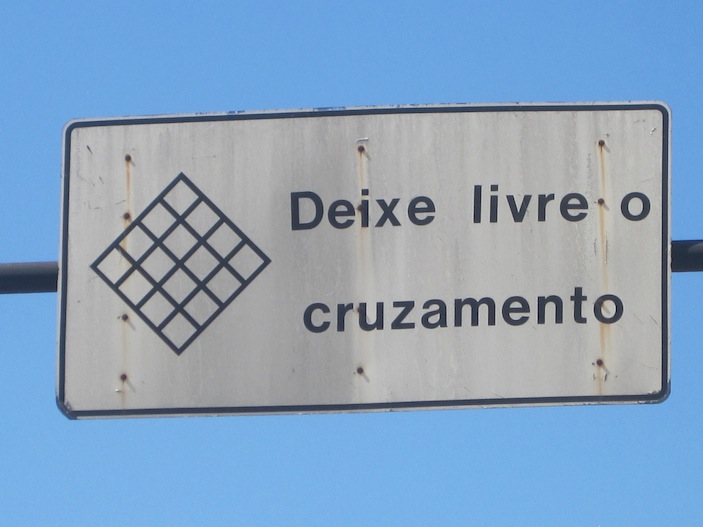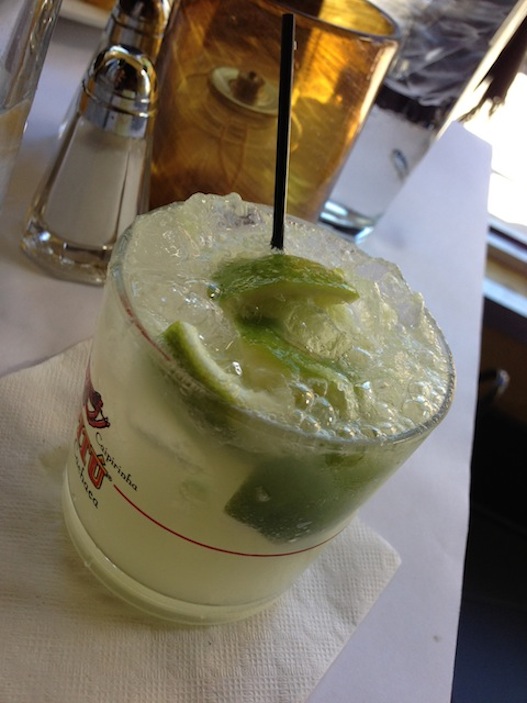Posts Tagged ‘IDrio’
IDriodejaneiro: Deixe Livre o Cruzamento
Nobody Does Carnival Quite Like Brasil
Easily the most anticipated holiday of the year in Brasil, this weekend’s event basically shuts down the country (with the exception of shopping, carnival workers and tourism industries, as nearly 70% of the country’s visitors come this week). In Rio de Janeiro alone, nearly five million people will participate, including nearly 500,000 from abroad.
While the celebration before Lent is celebrated around the world, nobody does it quite like Brasil. Every major city will host massive parades led by samba schools—dance groups that spend the entire year practicing to compete against one another during Carnival—which are televised and watched by anyone who isn’t there. Smaller cities have their own parades in which anyone can participate, basically turning the entire town into a marching party. Everywhere you look, trios elétricos (trucks equipped with deafening sound systems that drive around blaring samba music) will be driving around, followed by a contingent of people dancing instinctively to the rhythms as if compelled by nature. People sing, people dance, people wear costumes, and people drink. Indeed, it is estimated that this weekend alone will account for nearly 80% of the country’s beer consumption for the entire year.
While the style of celebration varies place to place, the epic nature of each city’s celebration is consistent. In the Southeast (most notably Rio), the festivities are dominated by traditional forms of samba—the enredo, the embalo, the bloco and the marchinha. In the Northeast (most notably Bahia), people enjoy more Afro-Caribbean influenced styles: the frevo, the maracatu, samba-reggae and Axé music.
The thought of an entire nation dancing for an entire weekend is probably unfathomable to most, but once you’ve experienced a Brazilian Carnival, that view may chance. So if the thought of it intrigues you, grab your dancing shoes and let’s go!
IDrio: No Bathing in the Sink!
Pay attention to the third one (from the right)–I guess we all need to be reminded of this every so often?
The Mystery of Cachaça’s (Lack of) Global Appeal
I’m on a mission, out for a cause. You see, I like to drink cachaça. And when I leave Brasil, I have a hard time finding it. That’s a problem.
No matter where you are in the world, go to a bar and you’re likely to see the usual suspects—Heineken, vodka, whiskey, the occasional gin or cognac, rum, a few local beers, maybe a Guinness—and that’s what you drink. And I have no issue with that. But I have yet to hear a good argument as to why vodka is deserving of worldwide fame and cachaça isn’t.
With beer, it’s simple. Beer is everywhere, and although there are hundreds of beers around the world that may taste better, Heineken is a global marketing machine, backed by hundreds of millions of dollars of marketing budget. But there is no brand of vodka, or any of the other liquors mentioned, that is ubiquitous. Sure, names like Grey Goose and Jack Daniels make a valiant effort, but it’s the drink itself, independent of brand name, that has the global fame and global reach.
More than 4,0000 brands of cachaça can be found in Brasil, which combine to produce an estimated 1.5 billion liters annually to the tune of approximately USD $130 billion in revenues. And yet, only 1 percent—one freakin’ percent—of that haul is exported (most of this to Germany, a testament to the wisdom of our Deutsch brethren). With that kind of production, consumption and bottom line, you’d think someone would have tried to grow this market outside of Brasil.
As for the drink itself, it is the distillation of pure sugar cane juice—a fresh, fragrant, aromatic and smooth distillate that is either prata (silver, or unaged) or ouro (gold, which the liquor resembles after it is aged)–typically anywhere from 38% to 50% alcohol by volume. The aging process can extend for anywhere from one to 15 years, and because of the added flavor it provides, aged cachaças tend to be more expensive and enjoyed by themselves. Unaged cachaças are most widely used mixed with muddled lime and sugar in the national drink of Brasil, the caipirinha (which happens to be, for my two cents, the best drink on the planet).
Also known as aguardente (“burning water”), pinga and caninha among other names, cachaça can be considered a relative to rum, except that rum is made from molasses (a byproduct from refineries that boil the cane juice to extract as much sugar crystal as possible), while cachaça is made from fresh sugarcane juice that is fermented and distilled.
So ironically enough, rum is actually a lower-quality offshoot of cachaça, and yet it enjoys global distribution while cachaça remains a Brazilian gem. Is that because of a cost difference? I doubt it, given that a wine-sized bottle of Pitú or 51 (Cinquenta y un), which are two of the most popular brands of unaged cachaça, can be gobbled up at supermarkets in Brasil for 4 or 5 reals, or the equivalent of about $2 USD.
The only conclusion I can think of is that cachaça makers spend their time and effort producing quality cachaça, rather than promoting their brands. Or perhaps this is just Brasil’s way of keeping one of their secret gems amongst themselves to enjoy, just to spite the rest of the world. But I have no doubt that with the right marketing strategy (see our tale about McDonalds’ humble introduction into France), cachaça would become a globally-enjoyed beverage, possibly above all others.
IDriodejaneiro: Parrot Smuggling!
IDriodejaneiro: “Tall and Tan and Young and Lovely…”
I’m not sure exactly what it is that made me find my comfort zone in Rio so quickly, on a bus rolling through downtown past Praça da República, but when I first set my eyes upon the shores of Ipanema, it’s hard to understand how I was ever nervous in the first place. Children playing,stunning bodies laying, and green trees swaying amidst turquoise waters under the watchful gaze ofPedra da Gávea…it seems such a contradiction to the chaos I was pre-conditioned to expect.
And that’s what I couldn’t get my mind off of the entire time I was there.
How can a place this beautiful, this festive…this free (because yes, the beach is public)…be so full of discontent? How can people turn a setting like this into a war zone? Especially when I feel so comfortable here?
I couldn’t get these thoughts out of my mind the entire time I was there. It was like although I was enjoying the scenery immensely, there was an element of awe with every person I walked by…
“I wonder if she lives in Rocinha?,” I’d find myself thinking.
“I wonder if he’s ever been in a gun fight?”
When I went to the Centro Cultural Banco do Brasil to see an exhibit of M.C. Escher’s work, I noticed a photo documentary of Rocinha (which is the largest favela in Brasil, and one of the most notorious for its violent reputation) in the bookstore. It was a striking image of a boy, no more than 7 or 8 years old, guarding a stash house with a Glock in his hand, staring into the camera. It was this image I just couldn’t shake from my mind with every step I took in the seeming paradise just a kilometer or two from the hills of Rocinha.
Naturally, this is what I’d want to learn about from every native of Ipanema or neighboring Leblon, and I learned something interesting. Firstly, that element of fear. Quite simply, it’s reality. You learn to live with it. And become conditioned to being able to go about your business, live your life, and enjoy the stunning beauty of the scene in front of you even if you did get mugged yesterday, or even if you did know someone who was robbed in a traffic jam last week and left for dead. You just don’t dwell on thoughts like these.
Number two, how this came to be. Apparently, the influx of mass quantities into the favelas ramped up in the 1950s and 1960s, when hordes of people would come from small villages throughout the country in hopes of cashing in on the economic opportunities the big city provided. Because they couldn’t afford proper housing, they would squat illegally on the public lands that surrounded small villages that had already been formed, and over the years, those villages grew and grew. No property was bought, nor taxed. The land was taken because the newcomers had nowhere else to go. Politicians didn’t want to stop the growth for fear of losing those votes, and a few decades later, Rocinha had grown to its estimated 250,000 residents—all squeezed into an area of about .86km². Introduce drugs into the community and not only did addiction set in, but it created a multi-million dollar industry amidst the dead-end career options that existed, and drug dealers have been controlling most of the favelas since. With the World Cup coming in 2014 and the Summer Olympics in 2016, this may be set to change…but for how long? Stay tuned.
IDriodejaneiro: Don’t Always Believe the Hype…
In the past 7 years, I have flown exactly 792,571 miles, or 1,275,519 km for you metric folks. East Coast, West Coast, Canada, Mexico…no sweat. Eastern Europe, Western Europe…Southeast Asia, the Far East…even the Middle East. No problem.
Last Friday was the first time I’ve ever been nervous upon arrival. Into Rio de Janeiro.
I guess that’s what happens when your only exposure to a place, besides a few nice pictures you saw online, are movies like Cidade de Deus (City of God) or Ônibus 174 (Bus 174). If you’ve seen either, you can understand. Through dramatically different series of events, each depicts a gruesome portrait of fear and violence that extreme poverty, particularly contrasted with great wealth, can nurture. Do a bit more research, and you learn about the Intercontinental Hotel that 10 drug dealers, engaged in a shootout with a rival gang, took hostage last September. Or the bullets that are known to occasionally pop across the main highway linking Galeao Airport to the city, dodging (hopefully) public buses and taxicabs full of tourists (prompting the city to, ever so gracefully, install walls painted with nice murals to keep the ‘noise’ out).
So naturally, when I caught the Real Autobus in the direction of Santos Dumont, I had to use every ounce of discipline I had to keep my camera in the pocket, fearing getting robbed, jumped, mugged, or worse. But then a funny thing happened. As we drove past Complexo de Alemão (favela), then Mal Jardim (favela), past São Cristóvão and down Av. Presidente Vargas through downtown, I started to give into the temptation.
Snap.
Snap, snap.
Snap, snap, snap…before we even arrived to Santos Dumont (from where I’d catch a taxi), I had already captured 50-some (albeit bad) images. I’m not sure exactly what it was, but it only took about 15 minutes, on a public bus no less, to find my comfort zone. I wasn’t afraid of Rio anymore.
.jpg)














